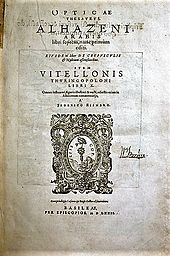Physics in the medieval Islamic world
The
Physics
One of the first commentaries of Aristotle's Metaphysics is by Al-Farabi. In "'The Aims of Aristotle's Metaphysics", Al-Farabi argues that metaphysics is not specific to natural beings, but at the same time, metaphysics is higher in universality than natural beings.[1]
Optics

One field in physics, optics, developed rapidly in this period. By the ninth century, there were works on physiological optics as well as mirror reflections, and geometrical and physical optics.[7] In the eleventh century, Ibn al-Haytham not only rejected the Greek idea about vision, he came up with a new theory.[8]
Ibn al-Haytham (known in
Astronomy

The Islamic understanding of the astronomical model was based on the Greek Ptolemaic system. However, many early astronomers had started to question the model. It was not always accurate in its predictions and was over complicated because astronomers were trying to mathematically describe the movement of the heavenly bodies. Ibn al-Haytham published Al-Shukuk ala Batiamyus ("Doubts on Ptolemy"), which outlined his many criticisms of the Ptolemaic paradigm. This book encouraged other astronomers to develop new models to explain celestial movement better than Ptolemy.[16] In al-Haytham's Book of Optics he argues that the celestial spheres were not made of solid matter, and that the heavens are less dense than air.[17] Al-Haytham eventually concludes that heavenly bodies follow the same laws of physics as earthly bodies.[18] Some astronomers theorized about gravity too, al-Khazini suggests that the gravity an object contains varies depending on its distance from the center of the universe. The center of the universe in this case refers to the center of the Earth.[19]
Mechanics
Impetus
John Philoponus had rejected the Aristotelian view of motion, and argued that an object acquires an inclination to move when it has a motive power impressed on it. In the eleventh century Ibn Sina had roughly adopted this idea, believing that a moving object has force which is dissipated by external agents like air resistance.[20] Ibn Sina made distinction between 'force' and 'inclination' (called "mayl"), he claimed that an object gained mayl when the object is in opposition to its natural motion. So he concluded that continuation of motion is attributed to the inclination that is transferred to the object, and that object will be in motion until the mayl is spent. He also claimed that projectile in a vacuum would not stop unless it is acted upon. This conception of motion is consistent with Newton's first law of motion, inertia, which states that an object in motion will stay in motion unless it is acted on by an external force.
Acceleration
In
See also
- Astronomy in the medieval Islamic world
- History of optics
- History of physics
- History of scientific method
- Islamic world contributions to Medieval Europe
- Islamic Golden Age
- Science in the medieval Islamic world
- Science in the Middle Ages
References
- ^ a b c Classical Arabic Philosophy An Anthology of Sources, Translated by Jon McGinnis and David C. Reisman. Indianapolis: Hackett Publishing Company, 2007. pg. xix
- ^ Bakar, Osman. The History and Philosophy of Islamic Science. Cambridge: Islamic Texts Society, 1999. pg. 2
- ^ Al-Khalili, Jim. "The 'first true scientist'". Archived from the original on 5 January 2009. Retrieved 4 January 2009.
- .
- ^ . Islam, Science, and the Challenge of History. New Haven:Yale University Press. pg 57
- ^ Dallal, Ahmad. Islam, Science, and the Challenge of History. New Haven: Yale University Press, 2010. pg. 38
- ^ Dallal, Ahmad. Islam, Science, and the Challenge of History. New Haven:Yale University Press. pg 39
- ^ K. B. Wolf, "Geometry and dynamics in refracting systems", European Journal of Physics 16, p. 14-20, 1995.
- ^ R. Rashed, "A pioneer in anaclastics: Ibn Sahl on burning mirrors and lenses", Isis 81, p. 464–491, 1990.
- ^ R. L. Verma, "Al-Hazen: father of modern optics", Al-Arabi, 8 (1969): 12-13
- ^ a b c D. C. Lindberg, "Alhazen's Theory of Vision and its Reception in the West", Isis, 58 (1967), p. 322.
- ^ OCLC 1676198.
- ^ David C. Lindberg, "The Theory of Pinhole Images from Antiquity to the Thirteenth Century," Archive for History of the Exact Sciences, 5(1968):154-176.
- ^ Taqī al-Dīn. Kitāb Nūr, Book I, Chapter 5, MS ‘O', folio 14b; MS ‘S', folio 12a-b
- ^ Dallal, Ahmad (1999), "Science, Medicine and Technology", in Esposito, John, The Oxford History of Islam, Oxford University Press, New York
- ^ Rosen, Edward. (1985). "The Dissolution of the Solid Celestial Spheres". Journal of the History of Ideas. Vol 46(1):13-31.
- ^ Duhem, Pierre. (1969). "To Save the Phenomena: An Essay on the Idea of Physical Theory from Plato to Galileo". University of Chicago Press, Chicago.
- ^ Mariam Rozhanskaya and I. S. Levinova (1996), "Statics", in Roshdi Rashed, ed., Encyclopedia of the History of Arabic Science, Vol. 2, p. 614-642 Routledge, London and New York
- ^ a b Sayili, Aydin. "Ibn Sina and Buridan on the Motion the Projectile". Annals of the New York Academy of Sciences vol. 500(1). p.477-482.
- ^ Espinoza, Fernando. "An Analysis of the Historical Development of Ideas About Motion and its Implications for Teaching". Physics Education. Vol. 40(2).
- ^ Zupko, Jack (2015). "John Buridan". The Stanford Encyclopedia of Philosophy. Metaphysics Research Lab, Stanford University. Retrieved 5 February 2019.
- ^ "Biography of Al-Biruni". University of St. Andrews, Scotland.
- ^ Nasr S.H., Razavi M.A.. "The islamic Intellectual Tradition in Persia" (1996). Routledge
- ISBN 965-223-626-8
